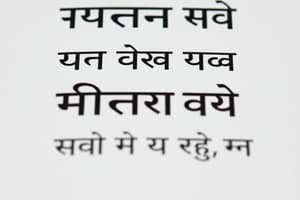Podcast
Questions and Answers
What language family does Hindi belong to?
What language family does Hindi belong to?
- Dravidian
- Indo-European (correct)
- Sino-Tibetan
- Austroasiatic
In which script is Hindi written?
In which script is Hindi written?
- Roman
- Greek
- Devanagari (correct)
- Cyrillic
Which of the following is a state where Hindi is widely spoken?
Which of the following is a state where Hindi is widely spoken?
- Tamil Nadu
- Uttar Pradesh (correct)
- Kerala
- Karnataka
Modern Standard Hindi is based on which dialect?
Modern Standard Hindi is based on which dialect?
What is the most common word order in Hindi?
What is the most common word order in Hindi?
Words borrowed from which language significantly contribute to the Hindi vocabulary?
Words borrowed from which language significantly contribute to the Hindi vocabulary?
What is the term for Sanskrit words used in Hindi without modification?
What is the term for Sanskrit words used in Hindi without modification?
Which characteristic is a feature of Hindi grammar?
Which characteristic is a feature of Hindi grammar?
Which of the following is a crucial role of the verb "to be" in Hindi?
Which of the following is a crucial role of the verb "to be" in Hindi?
What is the term for the combined form of Hindi and Urdu?
What is the term for the combined form of Hindi and Urdu?
Which of these scripts is used to write Hindi?
Which of these scripts is used to write Hindi?
Which of the following is a prominent Hindi dialect?
Which of the following is a prominent Hindi dialect?
What is the typical word order in Hindi?
What is the typical word order in Hindi?
What is Bollywood known for?
What is Bollywood known for?
What does the Kendriya Hindi Nideshalaya do?
What does the Kendriya Hindi Nideshalaya do?
In Hindi, are nouns gendered?
In Hindi, are nouns gendered?
Flashcards
"To be" verb role
"To be" verb role
A verb that helps form compound tenses and other grammatical structures.
Hindi dialects
Hindi dialects
Regional variations of Hindi that differ in vocabulary, pronunciation, and grammar.
Khariboli
Khariboli
A major Hindi dialect, known for its role in the development of modern standard Hindi.
Colloquial Hindi & Urdu
Colloquial Hindi & Urdu
Spoken forms of Hindi and Urdu that are mutually understandable.
Signup and view all the flashcards
Hindustani
Hindustani
The shared spoken base of Hindi and Urdu, despite script and formal vocabulary differences.
Signup and view all the flashcards
Central Hindi Directorate
Central Hindi Directorate
The standardization and development of Hindi.
Signup and view all the flashcards
Hindi word order
Hindi word order
Subject-Object-Verb
Signup and view all the flashcards
Hindi postpositions
Hindi postpositions
Words placed after the noun they modify, unlike English prepositions.
Signup and view all the flashcards
What is Hindi?
What is Hindi?
An Indo-Aryan language spoken primarily in India and one of the two official languages of the Union government of India.
Signup and view all the flashcards
Origin of Hindi
Origin of Hindi
Evolved from early forms of Prakrit through Shauraseni Apabhramsa; standardized mainly in the 19th and 20th centuries based on the Khariboli dialect.
Signup and view all the flashcards
Hindi Speaking States in India
Hindi Speaking States in India
Uttar Pradesh, Madhya Pradesh, Bihar, Haryana, Rajasthan, Himachal Pradesh, Uttarakhand, Delhi, Chhattisgarh, and Jharkhand.
Signup and view all the flashcards
Hindi's Linguistic Family
Hindi's Linguistic Family
An Indo-European language belonging to the Indo-Aryan branch, closely related to Urdu, Punjabi, Bengali, and Nepali.
Signup and view all the flashcards
Key Hindi Grammar Features
Key Hindi Grammar Features
Noun-verb agreement, postpositions, relatively free word order (SOV most common), and borrowing from Sanskrit, Persian, Arabic, and English.
Signup and view all the flashcards
Hindi Writing System
Hindi Writing System
Written from left to right in the Devanagari script, an abugida where each consonant has an inherent vowel sound 'a'.
Signup and view all the flashcards
Tatsam Words
Tatsam Words
Sanskrit words used in Hindi without modification.
Signup and view all the flashcards
Characteristics of Hindi Grammar
Characteristics of Hindi Grammar
Nouns are masculine or feminine; can be singular or plural; change form based on their function in the sentence (case); and verbs conjugate based on tense, aspect, mood, gender, and number.
Signup and view all the flashcardsStudy Notes
- Hindi is an Indo-Aryan language mainly spoken in India.
- It is one of the two official languages of the Union government of India, along with English.
Origin and History
- Hindi evolved from early Prakrit forms through Shauraseni Apabhramsa.
- Modern Standard Hindi comes from the Khariboli dialect of Delhi and nearby areas.
- Hindi became standardized in the 19th and 20th centuries.
- The British promoted Hindi as a language to unify the country during their rule.
Geographical Distribution
- Hindi is spoken in northern and central India.
- Hindi is commonly spoken in these states:
- Uttar Pradesh
- Madhya Pradesh
- Bihar
- Haryana
- Rajasthan
- Himachal Pradesh
- Uttarakhand
- Delhi
- Chhattisgarh
- Jharkhand
- A significant population of Hindi speakers also exists around the world.
Linguistic Features
- Hindi is an Indo-European language that belongs to the Indo-Aryan branch.
- It shares similarities with Urdu, Punjabi, Bengali, and Nepali.
- Hindi grammar includes:
- Agreement between nouns and verbs
- Postpositions, not prepositions
- A flexible word order, commonly SOV (subject-object-verb)
- Hindi has borrowed words extensively from Sanskrit, Persian, Arabic, and English.
Writing System
- Hindi is written using the Devanagari script.
- As an abugida, Devanagari has consonants with an inherent vowel sound, [a], which vowel marks can change or remove.
- The script runs from left to right.
- A horizontal line connects the letters in each word.
Vocabulary
- Hindi's vocabulary is rooted in Sanskrit and Prakrit.
- Persian, Arabic, and English have also contributed many words to it over time.
- तत्सम (Tatsam) refers to Sanskrit words in Hindi that are unchanged.
- तद्भव (Tadbhava) refers to Sanskrit words that have changed over time.
- देशज (Deshaj) are native words of local origin.
- विदेशज (Videshaj) are foreign words, mostly from Persian, Arabic, and English.
Grammar
- Hindi grammar is defined by:
- Gender: Nouns are either masculine or feminine
- Number: Nouns can be singular or plural
- Case: The form of nouns and pronouns changes depending on their role in a sentence
- Verb conjugations: Verbs change based on tense, aspect, mood, gender, and number.
- The verb "to be" (होना - hona) is essential for creating compound tenses and constructions.
Dialects
- The Hindi-speaking area has several regional dialects.
- Vocabulary, pronunciation, and grammar can vary among these dialects.
- Some main Hindi dialects are:
- Khariboli
- Braj Bhasha
- Awadhi
- Bhojpuri
- Bundeli
- Bagheli
Relationship with Urdu
- Hindi and Urdu are mutually understandable when spoken casually.
- The script and formal vocabulary are the main differences between them.
- Hindi uses Devanagari and borrows heavily from Sanskrit.
- Urdu uses a modified Persian script and borrows from Persian and Arabic.
- Hindustani is the term for the combined form of Hindi and Urdu.
Status and Usage
- Hindi is an official language of the Indian government.
- Government, education, and media use Hindi.
- In many parts of India, Hindi serves as a common language.
- Bollywood, the Hindi film industry, widely uses it.
- The Kendriya Hindi Nideshalaya (Central Hindi Directorate) works to standardize and develop Hindi.
Learning Hindi
- Many people learn Hindi both in India and overseas.
- Resources for learning Hindi include:
- Textbooks
- Online courses
- Language exchange partners
- Immersion programs
- Knowing Hindi is helpful for:
- Business opportunities in India
- Understanding Indian culture
- Enjoying Bollywood movies
- Traveling in India
Influence of Hindi
- Hindi has influenced other languages through loanwords.
- Globally, Hindi culture, especially Bollywood, has a significant influence.
- Hindi literature and poetry have a long and still-growing tradition.
Key differences between Hindi and English
- Word Order: Hindi usually uses Subject-Object-Verb (SOV), while English uses Subject-Verb-Object (SVO).
- Postpositions vs. Prepositions: Hindi uses postpositions (after the noun), but English uses prepositions (before the noun).
- Gendered Nouns: Hindi nouns have gender (masculine or feminine), which affects verb agreement, unlike English nouns.
- Verb Conjugation: Hindi verbs change based on gender, number, and tense, whereas English verb conjugation is simpler.
- Writing System: Hindi uses the Devanagari script (an abugida), while English uses the Latin alphabet.
Studying That Suits You
Use AI to generate personalized quizzes and flashcards to suit your learning preferences.




